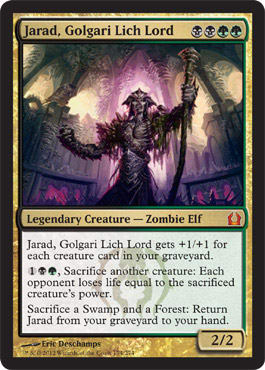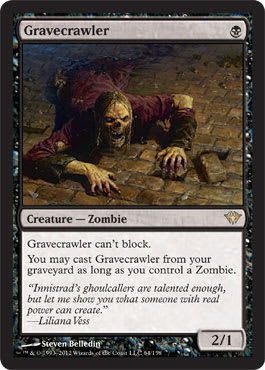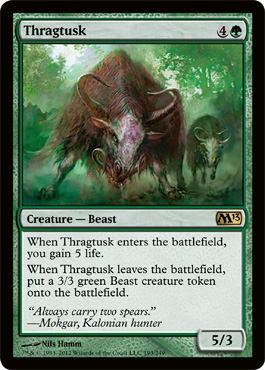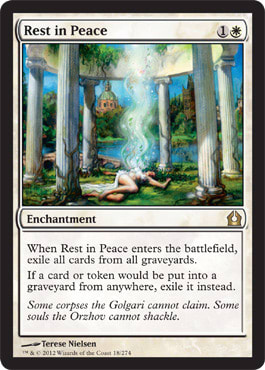Well, as the wise songstress Madonna said, “Beauty is where you find it,” and I found it with Jarad and the Golgari clan in Standard. I’ve been trying out various clans in Standard, most notably Selesnya and Azorius, but I haven’t become attached to any of them until now. Given my history with Recur/Survival and The Rock, it’s not terribly surprising that my journey through the current Standard environment has brought me to Golgari, and it looks as though it might be a long stop.
The main reason I haven’t been happy enough with my previous decks in this Standard environment is that they were just playing too fair—they weren’t doing sick enough things. With the TCGplayer championship tournament looming ahead of me and a day before a TCGplayer 5K in nearby Worcester, Massachusetts, I had a breakthrough. I started by looking at B/G Zombies and various reanimator decks, and as I considered cards such as Lotleth Troll and Grisly Salvage, I harkened back to the days of yore when I used to dominate Standard with a R/G deck that featured Firestorm, Mulch, and Lhurgoyf, among other goodies. Cue the Lich Lord.
This is what I quickly assembled:
"Lhurgoyfs!"
- Creatures (28)
- 4 Boneyard Wurm
- 4 Dreg Mangler
- 4 Gravecrawler
- 4 Lotleth Troll
- 4 Splinterfright
- 4 Ulvenwald Tracker
- 4 Jarad, Golgari Lich Lord
- Spells (8)
- 4 Grisly Salvage
- 4 Mulch
- Lands (24)
- 8 Forest
- 8 Swamp
- 4 Overgrown Tomb
- 4 Woodland Cemetery
- Sideboard (15)
- 3 Deathrite Shaman
- 3 Thragtusk
- 3 Vampire Nighthawk
- 2 Mutilate
- 2 Sever the Bloodline
- 2 Vraska the Unseen
The Build
The concept is simple. I use Trolls, Salvages, and Mulches to start filling my ’yard with creatures. I have Boneyard Wurms, Splinterfrights, and Lich Lords that love this. Further, I tried to stuff as many creatures as possible into the deck, giving priority to ones that are cool with being sent into the ’yard, such as Gravecrawler and Dreg Mangler.
I could also have played with Tracker's Instincts as another 2-mana spell for filling my ’yard, but I decided against it for three reasons. First, I’m not playing with blue mana; if I were, this card would be a no-brainer. Second, I want to ensure I don’t stall at 2 mana. Advantage: Mulch. Finally, I don’t want to play Mulch, Salvage, and Instincts—then, I would have too low of a creature count.
The Ulvenwald Trackers are excellent because the entire premise of the deck is to create giant creatures cheaply and quickly, and Trackers work great with fat friends. The deck has sixteen Zombies, which is somewhat influenced by wanting the option to bring back Gravecrawlers at will.
The Play
In a typical Game 1, I always play a Tracker on turn one if I have one. I want to bring one up and running a fast as possible. If I have a Troll, I never play a turn-one Gravecrawler against an unknown opponent. On turn two, I want to play Mulch, Salvage, or Troll. This is so important that I never mulligan a hand with a Salvage or a Troll and at least 2 mana, though I also need a creature to keep a Mulch-only hand. I will seriously consider mulliganing any hand that doesn’t have a Mulch, a Troll, or a Salvage.
Ideally, you want to be playing a Splinterfright (that’s at least a 1/1) on turn three, which is pretty difficult without one of your turn-two facilitators to fill your ’yard. The other best scenario involves you spending your turn two trading a Tracker for a mana Elf. Once you have your graveyard-filling started, turn four is usually spent doing two of the following: using a Tracker and/or playing a Wurm, Troll, Mulch, and/or Salvage. Depending on whether you think your opponent is playing with mass removal and if you have the right amount of board advantage, it’s now time to add a Lich Lord to the board. By the time you make it to 6 mana, you should be pretty much ready to finish off your opponent with Jarad’s creature-chucking ability.
The Matchups
Golgari isn’t the only guild being played in Standard right now. Azorius, Rakdos, and Selesnya are all seeing a lot of play at the moment. When I played this deck in the Worcester 5K, I ran into people playing all four of these guilds, though I didn’t see any Izzet decks. I played against a Golgari deck in the first round, but he seemed pretty inexperienced, and his deck seemed in need of tuning. In general, my deck had better synergy and bigger creatures, and I won pretty easily. At the end of the match, he told me that the first thing he was going to do when he got home was to build my deck.
I played against an Azorius midrange deck, built around Augur of Bolas, Snapcaster Mage, and a lot of instants. Unfortunately for him, his creatures were much smaller than mine, and while he had bounce, he didn’t have any actual removal. He had some permission, but I had way more big threats than he had counters for them. He brought in Supreme Verdict, but thanks to cards such as Gravecrawler, Lotleth Troll, Jarad, and Thragtusk, my deck is very resilient against removal. In addition, every time he kills some of my creatures, he makes my future Lhurgoyfs into even bigger threats. These dynamics helped me against Esper control as well.
Selesnya was a tougher matchup, but I still managed to come out ahead there as well. In general, my Trackers are much better than theirs since my creatures are so much bigger. They can usually make the games close with flyers and Thragtusks, but the combination of big trample creatures and the Lich Lord’s chucking ability are usually enough to outrace Selesnya.
One the toughest matchups for me was Rakdos, and it gave me one of my two losses. Rakdos had a strong combination of elements that were problems: speed, big-creature removal, flying, haste, direct damage, and even graveyard hate. Perhaps the biggest problem was the combination of Zealous Conscripts and Falkenrath Aristocrat. The matchup was made tougher because I had a thrown together sideboard for the 5K, which didn’t include Mutilate or Vampire Nighthawk.
The Sideboard
In most matchups, I’m either taking out the Trackers or the Gravecrawlers. If the opponent has a lot of creatures, Trackers are great and Gravecrawlers are kind of weak. If the opponent doesn’t have many creatures, Gravecrawlers rock and Trackers are pretty bad. As a result, I can usually find room to bring in at least four sideboard cards. If I want to bring in five or six cards, I typically take out a couple Jarads since he’s my slowest card, he’s a legend, and by the time I need him, I can often fetch him from my graveyard even if I only have a couple. Along similar lines, I can often take out a couple Wurms—they aren’t usually played until turn four, they’re among the less important cards in the deck, and cutting them makes me slightly less vulnerable to graveyard hate.
The only time I make wholesale changes when sideboarding is when I believe my opponent has Rest in Peace. In that case, I take out all of my Mulches, Wurms, and Splinterfrights, and I bring in all of my sideboard cards except for Deathrite Shamans. The Nighthawks and Thragtusks are solid because they give me non-graveyard-related offense, and they give me life-gaining against aggro decks; the Nighthawks help against flyers, and the Thragtusks help against removal.
The Results
I started out 4–0 in the 5K before losing to a R/G/W control/Wolf Run deck. He won a close first game largely because of a well-timed Selesnya Charm and an even timelier Angel of Serenity. He controlled Game 2 with Rest in Peace and Bonfire of the Damned. My second loss came a couple rounds later against the Rakdos deck I mentioned earlier. The worst turn was when I played a Thragtusk. He took it with a Zealous Conscripts, attacked me with it, and then sacrificed it to his Falkenrath Aristocrat, giving himself a Beast in the process. I hope that adding Mutilate and Nighthawk to my sideboard will improve that matchup.
I went into the last round with a record of 6–2. After losing Game 1 to a Selesnya deck, I was dismayed to see a Rest in Peace hit play in Game 2. Fortunately, I was able to win that game on the strength of a Tracker and a Troll, and I then sideboarded out my graveyard cards in Game 3 and was able to win the match. Despite starting 4–0, my tiebreakers were still bad, and I ended up finishing nineteenth (out of two hundred twelve), though half of the people with my 7–2 record made Top 16.
My results were good enough that as I write this, I’m happily preparing myself to play this deck at the championship in Indianapolis. I’m also ensuring that I’m going to have the Nighthawks, Mutilates, and Vraskas that I didn’t have in my sideboard at the 5K. I hope that as you read this, I’ll have just finished a strong showing in Indy. Even if you don’t have a championship to prepare for, I recommend you give this list a whirl. Not only is it pretty strong, but it’s actually quite fun to play. Just ask the Lich Lord . . .



























